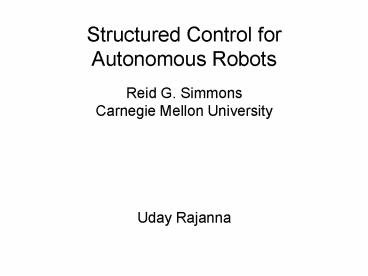Structured Control for Autonomous Robots - PowerPoint PPT Presentation
Title:
Structured Control for Autonomous Robots
Description:
Structured Control for Autonomous Robots. Reid G. Simmons. Carnegie Mellon University ... 2) It is a structured control approach where the. deliberative ... – PowerPoint PPT presentation
Number of Views:37
Avg rating:3.0/5.0
Title: Structured Control for Autonomous Robots
1
Structured Control for Autonomous Robots
- Reid G. Simmons
- Carnegie Mellon University
- Uday Rajanna
2
- Task Control Architecture
- 1) Layering reactive behaviours onto
deliberative components - 2) It is a structured control approach where the
deliberative components handle normal
situations and the reactive behaviours handle
exceptional situations. - 3) TCA control constructs facilitates modular
and evolutionary system development.
3
- Task Control refers to the problem of
coordinating perceptual, planning and execution
components of a robot system to achieve a given
set of goals - Behaviour Based Systems
- As the number of behaviours and the degree of
interaction between them grows, it becomes
increasingly difficult to design good arbitration
schemes of which behaviour takes a higher or
lower priority of execution.
4
- TCA Control Constructs
- 1) Distributed inter-process communication
- 2) Task decomposition and temporal constraints
- between subtasks.
- 3) Resource allocation and management.
- 4) Execution monitoring
- 5) Exception handling.
- TCA class of messages
- 1) Inform
- 2) Query
- 3) Goal
- 4) Command
- 5) Monitor
- 6) Exception
5
- Ambler walking system
- 1) Central Control
- 2) Gait Planner
- 3) Footfall planner
- 4) Leg recovery planner
- 5) Error recovery planner
- 6) Scanner Interface
- 7) Image Queue manager
- 8) Local terrain mapper
- 9) Message routing table
- 10) Resource Schedules
- 11) Task Trees
- 12) Real time controller
6
- TCA provides mechanisms for
- Deliberation
- Uses a task tree that keeps the overall
process in mind. Constraints like delay
planning, handling intervals, achievement
interval, goal - interval are used.
- Reactivity
- Uses task trees which are reactive in nature
in conjunction with the deliberation scheme
to account for sudden changes in environment
and exception errors. - TCA also allows for incremental development of
the system with minimal impact to the existing
architecture. - TCA module utilization was improved to be very
concurrent by the addition of DP between Take
Steps node and the node directly preceding its
parent.
7
- Conclusions
- 1) TCA provides a framework for developing and
controlling autonomous robots - 2) The control of planning, perception and action
must be well structured for general purpose
robots to succeed in rich and uncertain
environments. - 3) TCA supports both deliberative and reactive
architectures with the side coming into play
in case of exceptions and changes in
environments. - 4) Use of constraints provides a basis for
analysing interactions between behaviours. - 5) Using formal methods to analyse constraints on
behaviour would greatly facilitate
development of robot systems. - 6) Incremental addition of new modules can be
performed.































